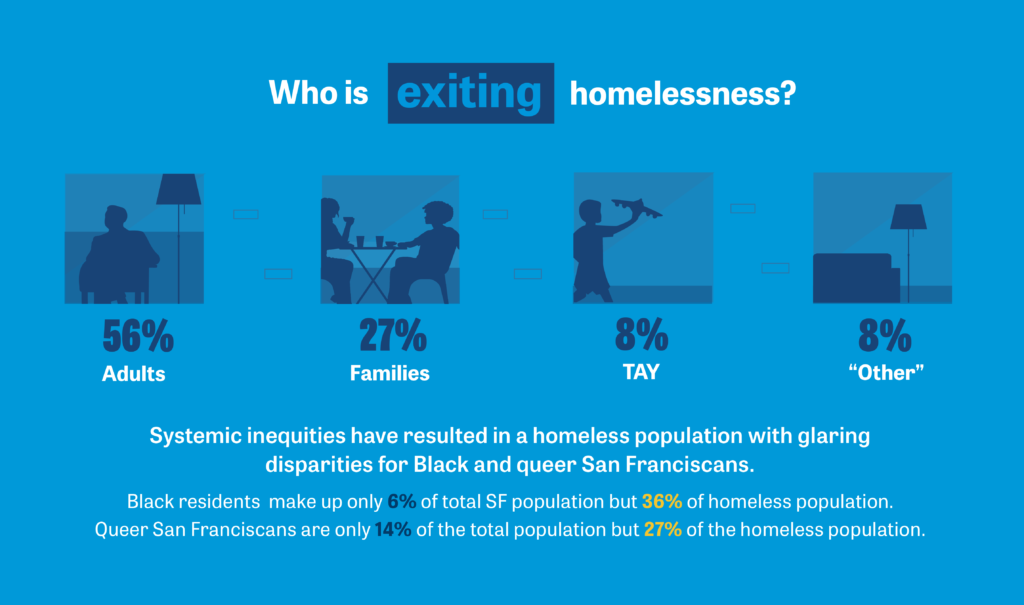From homeless to housed: August Snapshot
Every month, we track the number of people who exited homelessness in San Francisco so we can determine if we are on pace to meet our housing goals for the year. Staying on top of this information helps us ask the important questions – of ourselves and others – to make sure we are doing everything possible to get people off the streets and into homes.

In San Francisco, 104 people exited homelessness in the month of June, for a total of 617 people through June 2021. The City has acknowledged* that we are falling short of our housing goal for this year. One main challenge: the complex process to move people into homes that involves completing an assessment to determine a person’s level of housing need, qualifying for housing based on that assessment score, finding a matching unit based on available inventory, and securing the necessary documents to apply for housing, such as a California ID card, Social Security card, proof of income, and proof of homelessness.
This process would be cumbersome for any individual and becomes more complicated when trying to obtain documents that have been easily lost when living on the street and take a long time to request replacements for. To address this barrier, they are helping individuals obtain the required documents while also working to reduce the administrative requirements to shorten the amount of time between when a person is referred to an apartment and when they can move in.
*Source: LCHB Meeting, August 8th, 2021

To get in the queue for housing, a person experiencing homelessness in San Francisco must go through “coordinated entry,” a screening process that determines eligibility for housing, and if a person is eligible, then matches the person to the available home and services that fit their needs.
As part of its monthly reports on housing progress, publicly available through the Local Homeless Coordinating Board, the Department of Homelessness and Supportive Housing (HSH) has started publishing the demographics of individuals who are assessed in the coordinated entry process.
This information is a great starting point and should also be supplemented with demographic information about people moving into homes to truly capture efforts to end the disparities among people experiencing homelessness. For example, we know that the Flex Pool program has housed 114 Black residents – 43% of the total number of people housed by this program last year.
The Flex Pool is just one example of how access to a home and supportive services changes lives. In our recent blog post, we are honored to hear from Cameo House’s Rebecca Jackson, who shares her experience with homelessness and incarceration – two systems that disproportionately impact Black individuals and families as a result of institutional racism. Read about the compounding cycles of homelessness and incarceration and what it means for communities of color.
This month, we are unable to share the latest progress in the City’s Shelter In Place (SIP) Hotel rehousing effort due to insufficient data. Currently, the only publicly available data omits the exit destination information, making it difficult to know who moved into a permanent home and ended their homeless experience for good. Tracking progress to goals is a cornerstone of our campaign because it allows us to hold ourselves accountable. We will continue to monitor the availability of SIP rehousing data and push for reinstating the specific exit data.
We need you! All In is a campaign built on the people of San Francisco, and here’s how you can show up for our unhoused neighbors:
- Share this blog with three friends/colleagues on Facebook – Twitter to start a meaningful conversation about homelessness in our community.
- The solutions to homelessness start with YOU. Click below to sign the All In Pledge.
Stay up to date with the latest news about homelessness and housing in SF:
- Rebecca’s Story: And Still, She Rose
- She/Her/Hers: Surviving Homelessness As Women
- The pandemic has made homelessness more visible in many American cities
- There’s nearly $900 million for Bay Area rent relief. So why has only 10% gotten to residents?
- S.F. spends big to tackle homelessness, safety, drug crisis in final $13.2 billion budget





